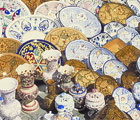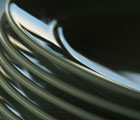 |
 |
 |
 |
 |
|
Modern Uses For Ceramics We commonly think of ceramics as art objects and decorations. But ceramics really are diverse pieces of multi-purpose material that are made from burning formed pieces of pottery. This shaped clay started out many years ago being hand-formed and was eventually made with a wheel to iron out any fingerprints or major imperfections.
CERAMICS |
|
A Brief History of Ceramic Tilesby C. McDougallThe earliest forms of ceramic tile date back to prehistoric times, when the use of clay as a building material was developed independently in several early cultures. The precursors of modern tile were roughly shaped and not nearly as strong as tiles today. The material was dug from river banks, roughly formed into building blocks, and baked dry in the sun. The first tiles were crude, but even 6,000 years ago people were decorating them by adding pigments for color and carving low-relief designs into their surfaces. Firing Tile Buildings in ancient Mesopotamian cities were fronted with unglazed terra-cotta and colorful decorative tiles. Ancient Greeks and Romans used ceramics for the floors, roofs, and even the plumbing in their buildings. The Chinese used a white clay called kaolin to develop the white-colored and durable ceramic known as porcelain. Tiles in medieval Europe were generally reserved for the floors of churches. Across the continent, the Byzantines excelled in using tile at a small scale; they created expressive mosaic patterns and murals using ceramic tile as well as pieces of glass and stone. Glazing Tile Persian ceramicists, inspired by imported Chinese porcelain, created a decorative tradition that spread across South Asia, North Africa, into Spain with the Moors, and eventually throughout Europe. Because their Islamic religion prohibited using human images in art, artisans turned to brightly colored tiles with ornate and intertwined patterns. Solid-color glazed tiles were cut and assembled into large-scale mosaics with subtle color gradations. The Muslim artisans also developed metal oxide glazes using tin, copper, cobalt, manganese, and antimony, which made tile glazes more brilliant and durable. By the fifteenth century, metal oxide-glazed tile had become popular in Italy, and their design influence moved northward with Italian craftsmen. Major European trading centers gave their names to local design motifs and types of tile that are still used, including delft tile (from Delft in Holland), and majolica tile (from Majorca in Spain). Modern Tile Today, most commercial tile manufacturers use the pressed-dust method of construction. First, a mixture of ingredients is pressed into the desired tile shape. Then the tile is glazed (or left unglazed) and baked in a kiln. Some tile makers may extrude tile shapes by squeezing them through a press into a die or by rolling them out flat and cutting the tile shapes with a form much like a cookie cutter. Whatever the method, all ceramic tile must be fired to become durable. The purity of the clay, the number of firings, and the temperature of the kiln determine the quality and price. Kiln temperatures vary from about 900° F to 2500° F. Lower firing temperatures produce more porous tile and soft glazes; higher temperatures produce dense, nonporous tile and hard glazes. For more information about ceramic tile and other flooring options visit http://www.discount-flooring-guide.com - Featuring comprehensive information about all types of flooring. About the AuthorManaging editor of http://www.discount-flooring-guide.com - Helping consumers understand and make the right flooring choice. |
|
�Copyright 2026 Tianxin-ceramic. All rights reserved.
Unauthorized duplication in part or whole strictly prohibited by international copyright law. |
